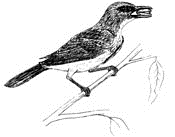Vertebrate Pest Conference: Proceedings

Vertebrate Pest Conference Proceedings: 17th (1996)
Date of this Version
1996
Document Type
Article
Citation
Published in Proceedings: Seventeenth Vertebrate Pest Conference … 1996, ed. Robert M. Timm & A. Charles Crabb (University of California, Davis, 1996).
Abstract
Various methods and approaches, including chemical and physical repellents, flooding, burrow fumigants, poison baits, vibrating devices and exclusion, have been explored for reducing mole problems. In addition to these, habitat management through reducing the moles food supply has received considerable attention, but environmental concerns and the lack of consistent results have tempered this approach. Over the years, trapping remains the best and most useful method of mole control. The pros and cons of some of the methods are discussed, along with some historical perspectives. The emphasis is placed on the Broad-footed mole, Scapanus latimanus, of California.
Included in
Animal Sciences Commons, Bioresource and Agricultural Engineering Commons, Environmental Engineering Commons


Comments
Copyright © 1996 (where applicable) by the Vertebrate Pest Council of the Vertebrate Pest Conference. Used by permission.